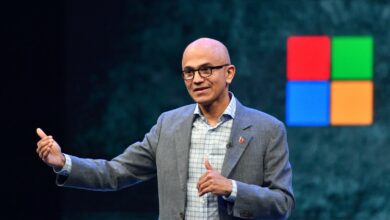Honda discovers a new ride in an entry cycle and an electric scooter. Volumes are enticing, and the market is slowing
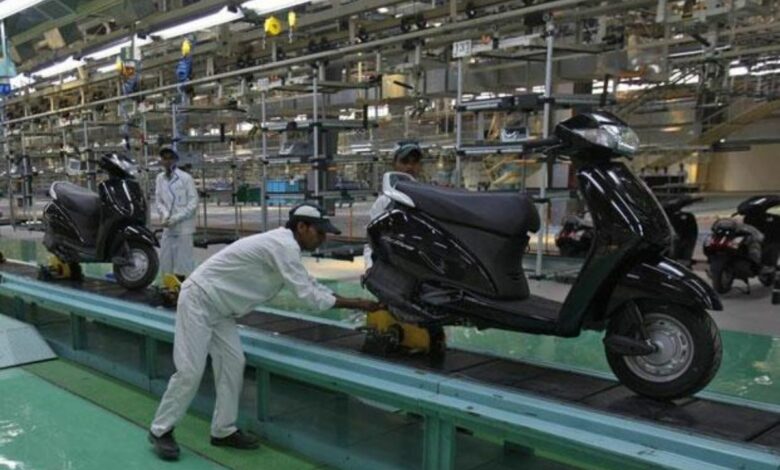
On March 22, 2011, As many people in the auto industry had feared for over a year; it was the good news they had been waiting for. How will Hero and Honda drive now that they’ve broken up for the first time in 26 years?
Over a decade later, Hero MotoCorp is still at the top of the two-wheeler heap of shame. Honda Motorcycle and Scooter India (HMSI) is on the next level down. While HMSI made a name for itself in the scooter market with the Honda Activa (110cc and 125cc), Hero rode on mass-market motorcycles like the Splendor + and HF.

As it stands, entry-level motorcycles with engines that have more than 75cc but less than or equal to 110cc are where the traffic is. SIAM says that these companies made over 55% of all motorcycles sold in India last year, and about 35% of sales came from 100cc and 110cc bikes.
HMSI hasn’t been in the market for low-cost 100cc commuter motorcycles, and it has now come to terms with that and is making things right.
Many low-end bikes still sell in India, but a lot of them are exported from India to other countries that are richer than India. When we thought about making a low-end model three years ago, we thought about how to do it. Atsushi Ogata, the managing director, president, and CEO of HMSI, tells ET Prime that this is a good chance for Honda to sell a product like this to people in rural areas of India because so many of them don’t have a lot of money to buy it.
The 100cc bike from HMSI is likely to be called Shine to build on the success of the 125cc Shine, which was a big hit.
But is the lure of big numbers the only reason HMSI is getting into the 100cc motorcycle market?
A long, slow ride
It’s not been a good time for the two-wheeler business recently. Fifty years ago this month, sales fell to their lowest level in a decade, and they were down 36% from last year. From over 6 million in FY19 to just 4 million this year.
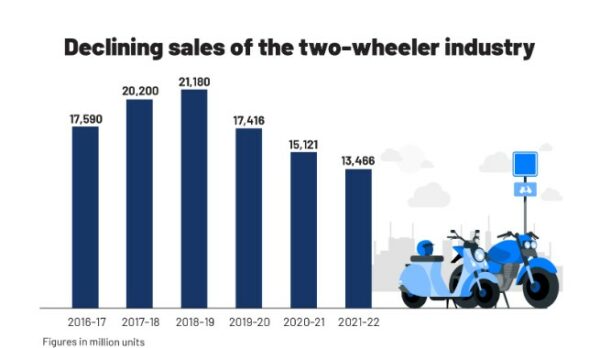
The prices of two-wheelers have gone up, and this is also true. When BS-VI emission standards were put into place in April 2020, they added about 10% to the cost of buying a car, and safety rules before that added 2% to 3%.
During the pandemic, big cities like Mumbai, Hyderabad, Chennai, and many small towns in Kerala, which are big markets for Honda scooters, saw many people lose their jobs and homes.
Honda’s sales took a hit because they rely on their scooters.
Urban sales were down because schools and colleges were closed for a few years. Women, who buy a lot of scooters, worked from home.
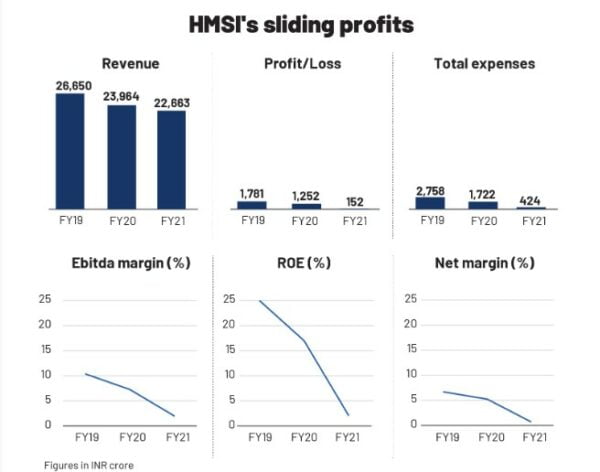
There is a chance that this has made HMSI change its strategy. The focus is now on the hinterland of India, where low-cost commuter bikes are the norm.
An important person at HMSI, YS Guleria, says that many people want to have a practical and safe motorcycle. This time, farmers will get a better price for their agricultural goods because they’re in the fields and have good crops. This will help the rural economy get back on its feet in time for the Honda 100cc bike to go on sale soon. “We are sure that there will be some green shoots in the rural economy by then,” says the group.
Then, Honda and other companies thought that the Indian auto industry would keep increasing, as it did in the late 1990s and the early 2000s when the number of two-wheelers grew by double digits. But the pandemic has changed things on the ground.
In the motorcycle industry, Ravi Damodaran is an expert. Ravi Damodaran: “One can’t gain market share by only focusing on the executive and premium segments [125cc or 160cc] and above.” Ravi Damodaran: 78 percent of motorcycles in use are commuter bikes, 100cc to 110cc. He thinks the Indian two-wheeler market will grow by 4% to 5% each year during the next three to five years, with hard-pressed buyers moving to the lower price ranges.
In FY22, HMSI had a market share of 50% in the scooter market, which was a little less than it had in FY21 (51.95%). It had 16.49% of the motorcycle market in FY22. Hero MotoCorp is the company that makes the most motorcycles, and in FY22, they had 48.28 percent of the market. Some of the bikes that HMSI sells are 110cc bikes, like Livo and CD110 Dream Deluxe.
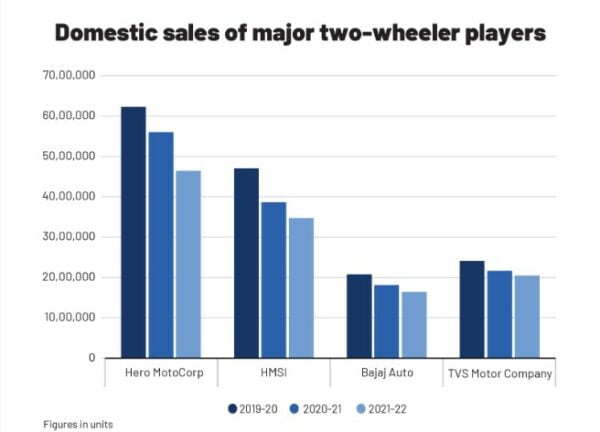
The low-risk bet
Is HMSI going to be able to make an impact on motorcycles with its new mass-produced bike?
“We will compete with other companies in this market because we have a different way of being accepted by customers,” says Ogata. To be sure, HMSI has a vast network of dealers and touchpoints, even in small towns.
They say that Honda has always been good at understanding the Indian market.
“Honda is known for being ahead of the game regarding new technologies.” It was the first to make 4-stroke motorcycles for people who go to work. Gearless scooters were the first to be made because more women joined the workforce. As time went on, it quickly replaced the Bajaj geared scooter to become the market leader in the scooter business, says Damodaran
Because of its high-quality products, HMSI is known all over the world. In this case, “the right product at the right price will help the company gain more market share,” says Mitul Shah, the head of research at brokerage firm Reliance Securities, the author of a new book.
Sales of the Hero HF Dlx, Bajaj Platina, and TVS Sport in 2021-22 were about 2.1 million. Ashish Pande, a regional director for the Federation of Automobile Dealers Associations (Fada) in Madhya Pradesh, said this. HMSI will make a new 100cc motorcycle in this group.
The Japanese company that makes two-wheelers is getting ready for new technologies that make it easier to get around. They’ve changed their Manesar plant in Haryana into a factory that makes things in India for the rest of the world. Europe, the United States, and Japan are all places the company wants to sell more of its goods. It also wants to make flex-fuel and electric two-wheelers that can be used in the local market.
The green-mobility focus is on.
There are a lot of Japanese car companies that make hybrids and electric cars. HMSI may have planned to start with a combination and then make an electric car by 2030. But the Indian market isn’t ready to pay for a hybrid, so that HMSI may have changed its plans for the country.
The country has seen a sudden surge in electric two-wheelers from start-ups and well-known companies. A typical thing for HMSI would have been for them to start selling their electric cars in Thailand and Indonesia first, and these countries are behind India when it comes to emission standards. HMSI seems very interested in letting people know that it wants to start testing an electric two-wheeler in India first.
Ogata says that HMSI’s first electric vehicle will be an electric scooter and will be shown off this fiscal year. All of them will be available in Q1 FY24.
Honda is trying to figure out if it would be easier to use a fixed battery pack for battery-electric cars (BEV). There are three main parts of a BEV: the motor, the control unit, and the battery pack: Our main goal is to make these three parts in India. This strategy is being talked about by HMSI and Honda Motor, Japan, who drive cars. We were able to come up with a solution, and now we’re going to start making the model.
Honda’s battery-swapping subsidiary, Honda Power Pack Energy India, was set up last December. It will help more people use electric cars for small vehicles. Starting in Bengaluru, the service will soon spread to other cities. It will also help other carmakers who use Honda’s battery packs in their systems get help with technical issues.
Pande of Fada thinks that Honda won’t make a high-end electric motorcycle right now because a robust charging infrastructure is needed even for a battery-powered bike. he says: “Motorcycles run for a long time, on highways and in rural areas where there isn’t a lot of power.”
A flex-fuel motorcycle is also in the works.
People learned about a new policy called the “National Policy on Biofuels” in 2018. The goal is to have a 20% mix of ethanol and petrol by 2025 to help people drive flex-fuel cars.
In Ogata’s words: “This is in line with the Indian government’s plans for new energy use in the future.” Our country, Brazil, has had this kind of technology for a long time, and it’s still at the level of Euro IV in Brazil.
He thinks it will be hard to mix the Euro-VI emission technology with Honda’s flex-fuel technology in India. “We’ll need some time, but we can do that.” The company wants to start putting flex-fuel technology into use and integrating it in India in stages. There is still a lot of debate about whether SIAM should use this technology.
The road ahead is long
Many HMSI’s works will be done outside of the United States. BS-VI products are thought to be good worldwide, which opens up markets in more advanced countries for its models.
Car prices will keep going up because of a chip shortage and input costs. There will be a low double-digit growth rate in Q1 of FY23. But new products could be the joker in the pack and give the company a boost in the money department. There will be a significant rise in exports, too.
Electric two-wheelers will be another area of study for HMSI.
If you want to have many electric vehicles in two or three years, you need to start now. It’s going to be a while before electric scooters become more popular, Shah from Reliance Securities says.
edited and proofread by nikita sharma



